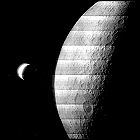 NASA’s fourth Lunar Orbiter satellite lifts off for its one-week trek to the moon. Placed into an orbit that takes it over the moon’s poles instead of its equator, Lunar Orbiter 4 is able to map virtually all of the near side of the moon over a period of two weeks. Plans to have Lunar Orbiter 4 map the far side are thwarted by mechanical failures and problems with the probe’s camera optics.
NASA’s fourth Lunar Orbiter satellite lifts off for its one-week trek to the moon. Placed into an orbit that takes it over the moon’s poles instead of its equator, Lunar Orbiter 4 is able to map virtually all of the near side of the moon over a period of two weeks. Plans to have Lunar Orbiter 4 map the far side are thwarted by mechanical failures and problems with the probe’s camera optics.

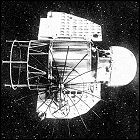 The Soviet Union launches Venera 4, a space probe dispatched to the planet Venus. Venera 4 is equipped with a landing probe which it deposits into the planet’s dense atmosphere in October, and the probe’s findings stun scientists on Earth who had long considered Venus a near-twin of Earth: the atmosphere is predominantly carbon dioxide, with minimal oxygen and a pressure nearly 100 times Earth’s atmospheric pressure at sea level. The temperature within the Venusian atmosphere is found to soar past 800 degrees Fahrenheit, presenting a challenge for designers of the next round of vehicles to visit the planet. The Venera 4 landing probe is not equipped with cameras, and contact is lost with it before contact is made with the ground.
The Soviet Union launches Venera 4, a space probe dispatched to the planet Venus. Venera 4 is equipped with a landing probe which it deposits into the planet’s dense atmosphere in October, and the probe’s findings stun scientists on Earth who had long considered Venus a near-twin of Earth: the atmosphere is predominantly carbon dioxide, with minimal oxygen and a pressure nearly 100 times Earth’s atmospheric pressure at sea level. The temperature within the Venusian atmosphere is found to soar past 800 degrees Fahrenheit, presenting a challenge for designers of the next round of vehicles to visit the planet. The Venera 4 landing probe is not equipped with cameras, and contact is lost with it before contact is made with the ground.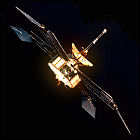 A near-identical twin of NASA/JPL’s unmanned Mariner 4 Mars probe, Mariner 5 lifts off en route to the planet Venus. Though the space probe’s architecture is similar to that of Mariner 4, Mariner 5 is modified to include solar shades to keep parts of the spacecraft cool, a problem which doesn’t exist at Mars. Mariner 5 takes almost exactly four months to reach Venus.
A near-identical twin of NASA/JPL’s unmanned Mariner 4 Mars probe, Mariner 5 lifts off en route to the planet Venus. Though the space probe’s architecture is similar to that of Mariner 4, Mariner 5 is modified to include solar shades to keep parts of the spacecraft cool, a problem which doesn’t exist at Mars. Mariner 5 takes almost exactly four months to reach Venus.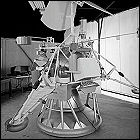 For the second time, one of NASA’s robotic Surveyor space probes fails to make it to the moon intact. Launched three days before,
For the second time, one of NASA’s robotic Surveyor space probes fails to make it to the moon intact. Launched three days before, 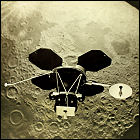 NASA’s final Lunar Orbiter satellite is sent to the moon, with a goal of completing the mapping of the moon’s surface left unfinished by mechanical issues with its predecessor. Lunar Orbiter 5 completes the mapping of the lunar far side and helps engineers and scientists determine signal coverage from the Earth-based tracking stations that will help NASA stay in contact with future Apollo missions to the moon.
NASA’s final Lunar Orbiter satellite is sent to the moon, with a goal of completing the mapping of the moon’s surface left unfinished by mechanical issues with its predecessor. Lunar Orbiter 5 completes the mapping of the lunar far side and helps engineers and scientists determine signal coverage from the Earth-based tracking stations that will help NASA stay in contact with future Apollo missions to the moon. After data returned by JPL’s Mariner spacecraft reveals that – as JPL predicted – Mars has a thin atmosphere and very low atmospheric pressure, plans for a Saturn V-launched orbiter with two 10,000-pound Mars landers are scuttled. The Voyager Mars mission, not expected to launch until
After data returned by JPL’s Mariner spacecraft reveals that – as JPL predicted – Mars has a thin atmosphere and very low atmospheric pressure, plans for a Saturn V-launched orbiter with two 10,000-pound Mars landers are scuttled. The Voyager Mars mission, not expected to launch until 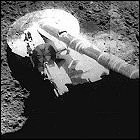 Despite an in-flight fuel pressure glitch that threatens to make this the third failure for the Surveyor program,
Despite an in-flight fuel pressure glitch that threatens to make this the third failure for the Surveyor program,  NASA launches Applications Technology Satellite-3, bundling new technology demonstrations onto a new weather satellite in geosynchronous orbit. Offering the first color view of Earth from that orbit, ATS-3 also relays weather data to specially equipped ground stations. It remains in service through
NASA launches Applications Technology Satellite-3, bundling new technology demonstrations onto a new weather satellite in geosynchronous orbit. Offering the first color view of Earth from that orbit, ATS-3 also relays weather data to specially equipped ground stations. It remains in service through  NASA’s robotic explorer
NASA’s robotic explorer 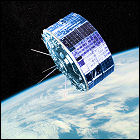 The recently-rechristened Environmental Sciences Service Administration launches, with the help of NASA, ESSA-6, the latest in a constellation of weather satellites operated by the former U.S. Weather Bureau. ESSA-6 remains in service until late 1969.
The recently-rechristened Environmental Sciences Service Administration launches, with the help of NASA, ESSA-6, the latest in a constellation of weather satellites operated by the former U.S. Weather Bureau. ESSA-6 remains in service until late 1969.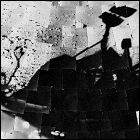
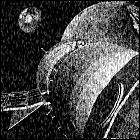 The Soviet Union launches an unmanned test flight of the Soyuz 7K-L1 command/service module, a spacecraft intended to orbit the moon with cosmonauts aboard. This unmanned flight, however, is designated Zond 4, and on its way back into Earth’s atmosphere it loses attitude control. With no precision guidance to ensure that Zond 4 will land on Soviet soil, Russian space authorities command the vehicle to self-destruct in mid-air to prevent their space technology from falling into another country’s hands. (The image accompanying this historical entry is computer-generated, and not a real photo.)
The Soviet Union launches an unmanned test flight of the Soyuz 7K-L1 command/service module, a spacecraft intended to orbit the moon with cosmonauts aboard. This unmanned flight, however, is designated Zond 4, and on its way back into Earth’s atmosphere it loses attitude control. With no precision guidance to ensure that Zond 4 will land on Soviet soil, Russian space authorities command the vehicle to self-destruct in mid-air to prevent their space technology from falling into another country’s hands. (The image accompanying this historical entry is computer-generated, and not a real photo.) The Soviet Union launches unmanned space probe Luna 14 toward the moon, where it takes up a lunar orbit and returns scientific data on cosmic rays and gravitational variances. This is the last orbital mission of the Luna series; future Luna vehicles will be landers or landers with rovers, some with sample return capability.
The Soviet Union launches unmanned space probe Luna 14 toward the moon, where it takes up a lunar orbit and returns scientific data on cosmic rays and gravitational variances. This is the last orbital mission of the Luna series; future Luna vehicles will be landers or landers with rovers, some with sample return capability. The Soviet Union launches Zond 5, a Soyuz 7K-L1 command & service module intended for flight around the moon. Rather than a cosmonaut crew, however, Zond 5 has biological specimens on board, including insects, plants, bacteria, and a pair of turtles – the first living creatures from Earth to orbit the moon. The specimens are all returned safely, though Zond 5 is the second consecutive Zond flight to lose attitude control after re-entry, splashing down in the Indian Ocean rather than making the customary propulsive return to Soviet soil. American intelligence agencies are aware of the mostly successful flight, and NASA alters the Apollo manned flight schedule to attempt to put men in orbit of the moon by the end of 1968.
The Soviet Union launches Zond 5, a Soyuz 7K-L1 command & service module intended for flight around the moon. Rather than a cosmonaut crew, however, Zond 5 has biological specimens on board, including insects, plants, bacteria, and a pair of turtles – the first living creatures from Earth to orbit the moon. The specimens are all returned safely, though Zond 5 is the second consecutive Zond flight to lose attitude control after re-entry, splashing down in the Indian Ocean rather than making the customary propulsive return to Soviet soil. American intelligence agencies are aware of the mostly successful flight, and NASA alters the Apollo manned flight schedule to attempt to put men in orbit of the moon by the end of 1968.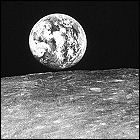 The Soviet Union launches an unmanned Soyuz 7K-L1 spacecraft, designated Zond 6, on a seven-day flight around the moon and back to Earth. Like Zond 5 before it, Zond 6 carries specimens of Earth animals and plants, but a rupture of the Soyuz pressure vessel results in these specimens being exposed to hard vacuum, resulting in instant death. Furthermore, the spacecraft opens and jettisons its parachutes too early, leaving it to slam into the ground at high speed. With continued glitches plaguing the Zond flights, Soviet mission planners aren’t confident enough in the 7K-L1 capsule to put cosmonauts in it for the next flight.
The Soviet Union launches an unmanned Soyuz 7K-L1 spacecraft, designated Zond 6, on a seven-day flight around the moon and back to Earth. Like Zond 5 before it, Zond 6 carries specimens of Earth animals and plants, but a rupture of the Soyuz pressure vessel results in these specimens being exposed to hard vacuum, resulting in instant death. Furthermore, the spacecraft opens and jettisons its parachutes too early, leaving it to slam into the ground at high speed. With continued glitches plaguing the Zond flights, Soviet mission planners aren’t confident enough in the 7K-L1 capsule to put cosmonauts in it for the next flight. NASA launches the second Orbiting Astronomical Observatory satellite, given the nickname “Stargazer” after it successfully enters service. OAO-2 will remain in service for over four years, making significant contributions to the scientific understanding of comets and supernovae. Two separate experiments, including one designed and overseen by Dr. Fred Whipple, observe the sky in ultraviolet light from Earth orbit.
NASA launches the second Orbiting Astronomical Observatory satellite, given the nickname “Stargazer” after it successfully enters service. OAO-2 will remain in service for over four years, making significant contributions to the scientific understanding of comets and supernovae. Two separate experiments, including one designed and overseen by Dr. Fred Whipple, observe the sky in ultraviolet light from Earth orbit.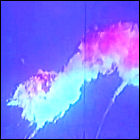 The gigantic Soviet-made N1 rocket, Sergei Korolev’s answer to the American Saturn V launcher, lifts off for the first time with an unmanned Zond spacecraft intended for a lunar flyby. Barely 70 seconds after leaving the pad, the N1 explodes at an altitude of seven miles, but the Zond space probe is salvaged by its escape tower rockets. The Soviet Union is no closer to safely sending a crew of cosmonauts to the moon.
The gigantic Soviet-made N1 rocket, Sergei Korolev’s answer to the American Saturn V launcher, lifts off for the first time with an unmanned Zond spacecraft intended for a lunar flyby. Barely 70 seconds after leaving the pad, the N1 explodes at an altitude of seven miles, but the Zond space probe is salvaged by its escape tower rockets. The Soviet Union is no closer to safely sending a crew of cosmonauts to the moon.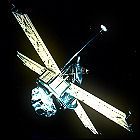 NASA and JPL launch the unmanned Mariner 6 space probe on a mission to Mars, where it will be joined by its yet-to-be-launched identical twin, Mariner 7. Mariner 6 will take five months to reach the red planet, with its slightly faster sister ship mere days behind it, and will fly past Mars twice as close as the planet’s previous unmanned visitors.
NASA and JPL launch the unmanned Mariner 6 space probe on a mission to Mars, where it will be joined by its yet-to-be-launched identical twin, Mariner 7. Mariner 6 will take five months to reach the red planet, with its slightly faster sister ship mere days behind it, and will fly past Mars twice as close as the planet’s previous unmanned visitors. The recently-rechristened Environmental Sciences Service Administration launches, with the help of NASA, ESSA-9, the latest in a constellation of weather satellites. ESSA-9 is the last weather satellite to carry the ESSA designation, as the government reorganizes ESSA into a new agency, NOAA, the following year. ESSA-9 remains in service until
The recently-rechristened Environmental Sciences Service Administration launches, with the help of NASA, ESSA-9, the latest in a constellation of weather satellites. ESSA-9 is the last weather satellite to carry the ESSA designation, as the government reorganizes ESSA into a new agency, NOAA, the following year. ESSA-9 remains in service until 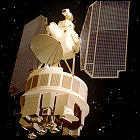 NASA launches the Nimbus 3 satellite, designed to observe weather patterns from orbit and test new weather and climate detection technologies. Nimbus 3 is the first Earth-orbiting spacecraft to test the SNAP-19 radioisotope thermoelectric generator system; devices similar to the SNAP-19 will become the primary power source for later deep space and outer solar system interplanetary missions. Nimbus 3 loses attitude control in
NASA launches the Nimbus 3 satellite, designed to observe weather patterns from orbit and test new weather and climate detection technologies. Nimbus 3 is the first Earth-orbiting spacecraft to test the SNAP-19 radioisotope thermoelectric generator system; devices similar to the SNAP-19 will become the primary power source for later deep space and outer solar system interplanetary missions. Nimbus 3 loses attitude control in 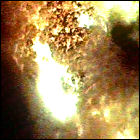 The Soviet Union’s second attempt to launch its moon rocket, the huge N1, ends disastrously. Again carrying an unmanned Zond spacecraft, the N1 barely clears the tower before stalling. Still full of highly flammable fuel, the N1 drops back to the ground, resulting in one of the most powerful man-made, non-nuclear explosions in history, completely wiping its launch tower and adjacent buildings off the map. (The Zond probe is lifted clear of the explosion by its escape rockets.) American spy satellites spot the damage to the nearby landscape from the explosion, tipping off the rest of the world to the N1 rocket program.
The Soviet Union’s second attempt to launch its moon rocket, the huge N1, ends disastrously. Again carrying an unmanned Zond spacecraft, the N1 barely clears the tower before stalling. Still full of highly flammable fuel, the N1 drops back to the ground, resulting in one of the most powerful man-made, non-nuclear explosions in history, completely wiping its launch tower and adjacent buildings off the map. (The Zond probe is lifted clear of the explosion by its escape rockets.) American spy satellites spot the damage to the nearby landscape from the explosion, tipping off the rest of the world to the N1 rocket program.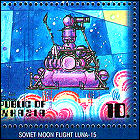 The Soviet Union launches unmanned space probe Luna 15 toward the moon, the Soviet space program’s last attempt to claim a victory in the race to the moon. Intended to land on the moon and gather a core sample of lunar soil which will then be rocketed back to Earth, hopefully ahead of the arrival of lunar soil samples from the concurrent American Apollo 11 moon landing attempt, Luna 15’s lander detaches and attempts its landing on July 20th…only to crash into the moon’s surface, losing all contact with Earth, while NASA astronauts Neil Armstrong and Buzz Aldrin prepare to depart with their soil samples intact. In a rare display of international cooperation, the Soviets shared basic orbital parameters of Luna 15’s flight with NASA to avoid any navigational hazards for Apollo 11.
The Soviet Union launches unmanned space probe Luna 15 toward the moon, the Soviet space program’s last attempt to claim a victory in the race to the moon. Intended to land on the moon and gather a core sample of lunar soil which will then be rocketed back to Earth, hopefully ahead of the arrival of lunar soil samples from the concurrent American Apollo 11 moon landing attempt, Luna 15’s lander detaches and attempts its landing on July 20th…only to crash into the moon’s surface, losing all contact with Earth, while NASA astronauts Neil Armstrong and Buzz Aldrin prepare to depart with their soil samples intact. In a rare display of international cooperation, the Soviets shared basic orbital parameters of Luna 15’s flight with NASA to avoid any navigational hazards for Apollo 11.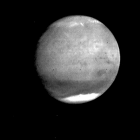 The unmanned NASA/JPL space probe Mariner 6 makes its closest flyby of planet Mars, coming as close as just over 2100 miles from the Martian surface. While measuring the composition of the Martian atmosphere and trying to analyze its surface from space, Mariner 6 passes over densely cratered terrain, not spotting the huge canyons and volcanoes that will later become synonymous with Mars. Mariner 6’s identical twin, Mariner 7, is just days behind it, and ground controllers rewrite Mariner 7’s flight plan to get closer looks at surface features first spotted by Mariner 6.
The unmanned NASA/JPL space probe Mariner 6 makes its closest flyby of planet Mars, coming as close as just over 2100 miles from the Martian surface. While measuring the composition of the Martian atmosphere and trying to analyze its surface from space, Mariner 6 passes over densely cratered terrain, not spotting the huge canyons and volcanoes that will later become synonymous with Mars. Mariner 6’s identical twin, Mariner 7, is just days behind it, and ground controllers rewrite Mariner 7’s flight plan to get closer looks at surface features first spotted by Mariner 6.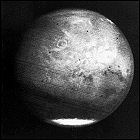 The unmanned NASA/JPL space probe Mariner 7 makes its closest flyby of planet Mars, coming as close as just over 2100 miles from the Martian surface. Having recently suffered an inexplicable but temporary loss of communications with Earth (later determined to be caused by a leaky on-board battery), Mariner 7’s flight plan is reprogrammed just days out from Mars based on some of the more interesting findings of its sister ship, Mariner 6. The success of the tandem flight to Mars convinces NASA to adopt a similar mission profile for the upcoming Mars ’71 missions, which will send two Mariner orbiters to take up permanent positions around Mars.
The unmanned NASA/JPL space probe Mariner 7 makes its closest flyby of planet Mars, coming as close as just over 2100 miles from the Martian surface. Having recently suffered an inexplicable but temporary loss of communications with Earth (later determined to be caused by a leaky on-board battery), Mariner 7’s flight plan is reprogrammed just days out from Mars based on some of the more interesting findings of its sister ship, Mariner 6. The success of the tandem flight to Mars convinces NASA to adopt a similar mission profile for the upcoming Mars ’71 missions, which will send two Mariner orbiters to take up permanent positions around Mars. The Soviet Union launches the Zond 7 unmanned spacecraft, an unmanned version of the Soyuz 7K-L1 space vehicle intended to take cosmonauts around the moon. Carrying no crew, this vehicle takes pictures and tests various spacecraft systems without risking human lives. Zond 7 returns to Earth using an unusual multiple-skip atmospheric re-entry profile on August 14th. If Zond 7 had been carrying a crew, this would have been the first nominal flight of the Soyuz 7K-L1 vehicle. No cosmonaut crews would reach the moon prior to the dissolution of the Soviet Union in the late 20th century.
The Soviet Union launches the Zond 7 unmanned spacecraft, an unmanned version of the Soyuz 7K-L1 space vehicle intended to take cosmonauts around the moon. Carrying no crew, this vehicle takes pictures and tests various spacecraft systems without risking human lives. Zond 7 returns to Earth using an unusual multiple-skip atmospheric re-entry profile on August 14th. If Zond 7 had been carrying a crew, this would have been the first nominal flight of the Soyuz 7K-L1 vehicle. No cosmonaut crews would reach the moon prior to the dissolution of the Soviet Union in the late 20th century.